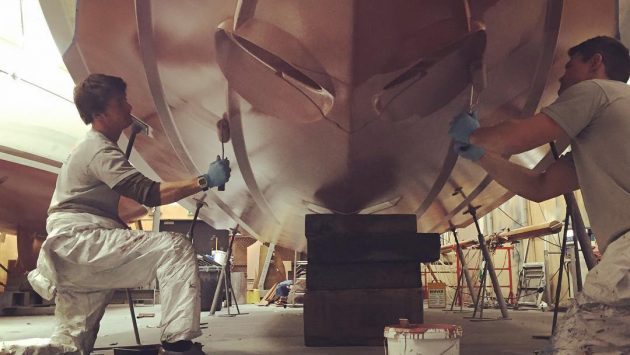With a modern water-based and VOC-free epoxy Coppercoat gives off no dangerous solvents or unpleasant smells
Visit a boatyard now and you’ll be greeted by the unpleasant smell of solvents. Known as VOCs (Volatile Organic Compounds), solvents are a major component of traditional antifoul paints, many of which contain up to 45% VOCs.
These solvents pose a problem – they’re major contributors to climate change. To help reduce global warming, regulators are moving to decrease VOC contents, to the point of elimination.
The atmosphere is not the only area at risk. Traditional antifouls work by releasing a toxic cocktail of biocides, designed to deter the slime, weed and shell fouling. As these antifouls erode, along with the biocides they release pigments and binders into the ecosystem.
Again, regulators are moving in to limit the damage. Within Europe and the UK, the choice of biocides available to paint manufacturers has reduced from over 50 to less than 10.
The speed at which biocide is released – the leach rate – is also under scrutiny, looking likely to follow California and Sweden in being limited to 9 micrograms per cm2 per day.

Recently, ‘Biocide Free’ coatings (typically designed to work by presenting a slippery surface to which fouling struggles to adhere), have been made available to yachtsmen. But while these products do not contain biocides, they generally contain approximately 35% solvent, require a solvent-based primer, need to be washed off after a few years with a 65% solvent solution, break down to produce microplastics, and can leach silicone oils.
Perhaps more worryingly, many biocide-free coatings still contain PFAS Compounds* that are currently being banned in countries such as Germany, Sweden and the USA. (*PFAS Compounds, known as ‘forever chemicals’, are synthetic compounds that do not break down in the environment.)
While these restrictions spell bad news for traditional antifouls and biocide-free coatings, the better news is that a proven and legally compliant solution already exists.
Coppercoat already meets these regulations and has done so since its launch in 1991. Coppercoat combines a single biocide (an exclusively sourced copper powder made in the UK from recycled copper wire) with a modern water-based and VOC-free epoxy, so gives off no dangerous solvents or unpleasant smells.
And with a minimal leach rate of just 1.9 micrograms per cm2 per day, Coppercoat is the logical, environmentally responsible and effective choice for antifouling.

What would be the positive impact of using Coppercoat in place of traditional antifoul paint?
For comparison purposes, let’s use a theoretical marina containing 500 leisure boats at an average size of 12m (39ft) per boat.
Such a boat would typically use 10 litres of antifoul, for the recommended two coat application. At 45% solvent, this equates to 4.5 litres of solvent dissipating to the atmosphere during application. For 500 boats, this is 2,250 Kg. Every year.
If all these boats switched to Coppercoat, which is solvent-free, this figure would be ZERO!
Looking at the remaining paint components such as binders, pigments and biocides and assuming a typical reduction in paint thickness of 80% over the year, 7,700 Kg of solids would leach into the sea. Every year.
If all these boats switched to Coppercoat, with its vastly lower leach rate, this figure would be just 175 Kg.
But importantly, with the average lifespan of a treatment of Coppercoat being 10 years, over the course of a decade, switching to Coppercoat could reduce the marina VOC emissions from antifoul by 22,500 Kg, and reduce paint-solids leaching by 77,000 Kg.
Coppercoat has always been the choice for those looking to minimise the time and costs associated with antifouling. It’s now also being seen as the more environmentally responsible choice.




